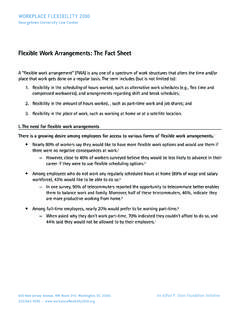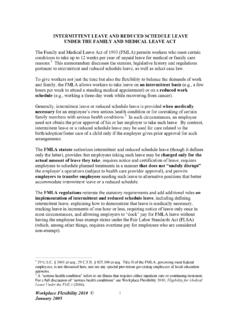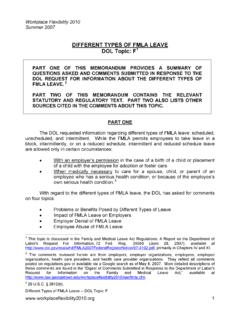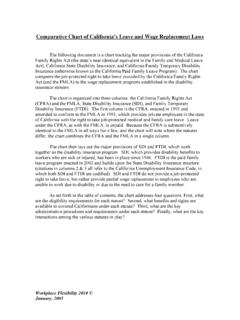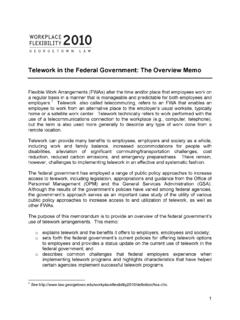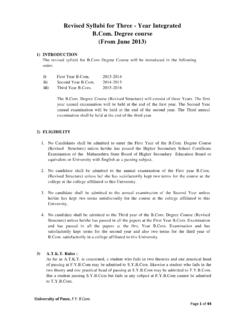Transcription of Flexible Work Arrangements: Selected Case Studies
1 WORKPLACE FLEXIBILITY 2010 Georgetown University Law Center600 New Jersey Avenue, NW, Room 340, Washington, DC 20001 An Alfred P. Sloan Foundation Initiative202/662-9595 Work Arrangements: Selected case StudiesEmployees have shown a great desire for Flexible work arrangements (FWAs). National data reveals that nearly 80% of workers say they would like to have more Flexible work options and would use them if there were no negative consequences at However, most workers do not have access to Flexible work arrangements and barriers to their effective implementation persist in many organizations as the following nationally representative employer-based survey data reveals:- 32% of employers do not allow any workers to change their starting and quitting times, and 67% do not allow all or most employees to do so.
2 - 61% do not allow any workers to control which shifts they work; - 47% do not allow any employees to move from full time to part-time and back again while remaining in the same position, and 79% do not allow most or all employees to do so;- 54% do not allow any workers to share jobs; 66% do not allow any employees to work part of the workweek at home on either an occasional or a regular basis; and- 61% do not allow any workers to work a compressed work week for at least part of the businesses have responded and various Studies indicate both a growth in Flexible work options and an expanded understanding of their relevance to workforce recruitment, morale, production, and However, to the extent that flexibility is available, access differs considerably across occupations with managerial, administrative and professional workers having the most information on FWA characteristics, access and utilization is not available across job sectors and occupations.
3 Most publicly available literature on the implementation of FWAs is employer-based and tends to emphasize the processes through which companies develop and market their Flexible arrangements and only minimally describes the specific details of actual policies and their use. To the extent that these programs have been documented, several themes emerge. The catalyst for change often begins with employees. Companies may learn of employee dissatisfaction through a survey or a needs-assessment, or supervisors may be approached by individual employees with compelling requests for Flexible work.
4 Occasionally, the process begins at the top; in these cases, companies may be trying to address a systemic problem like high turnover rates or absenteeism. While some Flexible work arrangements have formal written policies with specific eligibility and utilization parameters, many others rely upon individual negotiations with willing managers who exercise explicit or permissive scopes of discretionary decision-making. The scope of coverage can be broad or specific to categories of workers. Many of the references we found to FWAs suggest their availability to all workers at a given company, although this was not something we could confirm.
5 Other corporate information made it clear that certain types of occupational groups were excluded from participation in FWAs (such as manufacturing 2units). Even when FWAs are part of official company policies, managerial commitment to the benefit and discretion in its approval significantly impacts actual use. Public and private Studies indicate that the following contribute to improved adoption of Flexible arrangements across job settings: leadership at the highest levels; written policies and broad dissemination to workers; implementation training for decisional managers; and review and enforcement mechanisms including employee surveys, utilization data collection and review, and managerial performance assessments.
6 Available literature suggests that some of the most successful programs are those that are developed jointly by employees and company management. The following case Studies , then, provide a glimpse into what these programs look like in on behalf of Workplace Flexibility 2010 by Jean Flatley McGuire, PhD and Phyllis Brashler, Doctoral Candidate; Northeastern University, Bouve College of Health Study 1 Company: Kraft Foods5 Profile: A food and beverage manufacturing company, Kraft and its subsidiaries employ nearly 109,000 people in over 150 countries. In the , Kraft employs 62,000 people in 100 plants; 59% of these employees are hourly : Employee dissatisfaction, particularly among hourly workers in manufacturing plants Solution: A Flexible work options program called Fast Adapts for hourly employees and production supervisors who work in 24/7 manufacturing facilitiesPolicy Parameters: Fast Adapts allows workers to swap shifts, take single-day vacations, and request job-sharing arrangements, pending the approval of their plant manager or supervisor.
7 It also allows plants to utilize retirees to cover shifts for employees out on leave, on vacation or out with extended illnesses. All hourly workers are eligible to use Fast Adapts options if the arrangements are conducive to the employees specific work process, plant policy, or union contract. If not, plant and HR managers are encouraged to create alternative Flexible work solutions. Although all employees are eligible for Flexible work arrangements and all plants are expected to implement Flexible work strategies, plant managers & HR directors have the discretion to develop FWAs consistent with individual site & Oversight: The Fast Adapts program was an outcome of a Work-Life Summit including line workers, production supervisors, plant managers, and plant human resource managers.
8 Following the summit, Area HR Directors conducted meetings with Plant HR Directors and union representatives to address the compatibility of program initiatives with existing union contracts. The Fast Adapts program was piloted in a few plants before being rolled out to all locations. Although existing newsletter, video mechanisms and plant meeting structures were utilized, communicating information about Fast Adapts to employees throughout the 80+ manufacturing plants in the United States was a significant challenge. When first implemented in 2002, plant managers were expected to develop and implement Flexible work strategies for their plants within a specified period of time; if unable to do so, managers were required to provide a written explanation for the delay and develop an alternative action plan.
9 After the adoption of the Fast Adapts program, each plant was required to include a work-life component in its Employee and Organization Excellence Plan; plan is reviewed annually. 4 Plants are not required to track usage of Fast Adapts programs, but plant managers are surveyed by Human Resources and asked to provide updates on the extent to which the programs have been adopted. Work/Life Directors report back to the Vice President of Human Resources & the four Area Vice Presidents to whom the plant managers report. In addition, a bi-annual employee satisfaction survey conducted at each plant asks employees about their work/life : The 2003 employee satisfaction survey revealed improved employee satisfaction with work-life Galinsky, E.
10 , Bond, , & Hill, (2004). When Work Works: A status report on workplace flexibility. Who has it? Who wants it? What difference does it make? New York, NY: Families and Work Institute, p. Bond, James T., Galinsky, E., Kim, S., & Brownfield, E. (2005). National Study of Employers. New York, NY: Families and Work Institute, p. See for example, Meyer, , Mukerjee, S., Sestero, A. (2001). Work-family benefits: Which ones maximize profits? Journal of Managerial Issues 13(1), p. 38; Also, see Halpern, (2005, May). How time- Flexible work policies can reduce stress, improve health, and save money.
